Pesticide handlers must wear the personal protective equipment (PPE) required by the pesticide label, and it must be provided by his or her employer (handler employer). In addition, agricultural employers must provide and maintain PPE for use by early entry workers.
These items are not considered "PPE." Employers are not required to provide/maintain them, even when they are required by a pesticide product labeling as PPE:
- Shirts
- Pants
- Shoes
- Socks
Under the WPS, personal protective equipment (PPE) includes:
Click on the items above to learn more.
Workers and handlers are not allowed to take home employer-provided PPE contaminated with pesticides. Handlers must have a place, away from pesticide storage/use, where they can:
- store personal clothing not worn during handling activities,
- put on PPE at the start of any exposure period, and
- remove PPE at the end of any exposure period.
Early-entry workers
It is the employer's responsibility to provide each early-entry worker with the PPE specified in the pesticide product labeling for early entry and ensure that it is used as intended. Workers don't have all of the same training that pesticide handlers do.
The agricultural employer must:
- Provide each early-entry worker with instruction on the proper use and removal of the PPE, and if appropriate, its cleaning, maintenance and disposal.
- Only allow early-entry workers to wear PPE after they have received instruction in the prevention, recognition, and first aid treatment of heat-related illness.
Use, cleaning and maintenance of PPE
The employer must ensure that:
- PPE is used correctly for its intended purpose and is used according to the PPE manufacturer's instructions.
- All PPE is inspected for leaks, holes, tears, or worn places before each day of use. Any damaged equipment must be repaired or discarded.
- All PPE is cleaned according to the manufacturer's instructions or pesticide product labeling instructions before each day of reuse. In the absence of any such instructions, PPE must be washed thoroughly in detergent and hot water.
- All washed PPE is dried thoroughly before being stored or reused.
- All clean PPE is stored separately from personal clothing and apart from pesticide-contaminated areas.
- Contaminated PPE is made unusable as clothing or unavailable for any use by anyone, if the PPE cannot or will not be cleaned properly.
- Any coveralls or other absorbent materials that have been drenched or heavily contaminated with a pesticide that has the signal word "DANGER" or "WARNING" on the pesticide label are discarded (not re-used) in accordance with applicable regulations.
- Any person who handles contaminated PPE must wear the gloves specified on the pesticide product labeling for mixing and loading the product(s) of the contaminant(s).
- Contaminated PPE is kept separately from non-contaminated PPE, other clothing or laundry, and washed separately from any other clothing or laundry.
3rd Party Laundry Service
Before allowing someone to clean contaminated PPE, the employer must notify them of the following:
- That such equipment may be contaminated with pesticides and there are potentially harmful effects from exposure to pesticides.
- The correct way(s) to clean PPE and how to protect themselves when handling such equipment.
- Proper decontamination procedures that should be followed after handling contaminated PPE.
Heat-related illness
When a WPS-labeled pesticide product requires the use of PPE for a handler activity, the handler employer must take appropriate measures to prevent heat-related illness. These measures may include altering time of work hours to avoid or limit working in the hottest/most humid situations, providing adequate water breaks and cool-down periods, allowing removal of PPE when not required, etc.
There are several exceptions to PPE required by pesticide product labeling, but there are no exceptions when a respirator is required. Exceptions are listed in the WPS Exceptions Guide.


